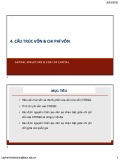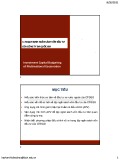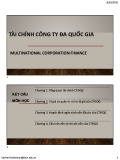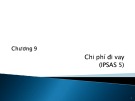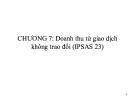International Financial Accounting
Chapter 7: RECEIVABLES
International Financial Accounting
Chapter 7: RECEIVABLES
MA. Nguyen Quoc Nhat
Learning Objectives
Define and explain common types of receivables and
review internal controls for receivables Use the allowance method to account for
Uncollectible
Understand the direct write-off method for
Uncollectible
Account for notes receivable Report receivables on the balance sheet and evaluate a
Chapter’s content 7.1 Receivables: An Introduction 7.2 Accounting for Uncollectible (Bad Debts) 7.3 The Allowance Method 7.4 The Direct Write-Off Method 7.5 Credit-Card and Debit-Card Sales 7.6 Notes Receivable 7.7 Using Accounting Information for Decision Making
company using the acid-test ratio, days’ sales in receivables, and the accounts receivable turnover ratio
7.1 Receivables: An Introduction
7.1 Receivables: An Introduction
Types of Receivables The two major types of receivables are ● accounts receivable, and ● notes receivable.
RECEIVABLES
RECEIVABLES
5
6
MA. NguyenQuocNhat –nhatnq.faa@gmail.com
1
You have a receivable when you sell goods or services to another party on credit. You also have a receivable when you loan money to another party. So a receivable is the right to receive cash in the future from a current transaction. It is something the business owns; therefore, it is an asset. Each receivable transaction involves two parties: ● The creditor, who will collect cash from the customer. ● The debtor, who takes on an obligation/payable (a liability). The debtor will pay cash later.
International Financial Accounting
Chapter 7: RECEIVABLES
7.1 Receivables: An Introduction
7.1 Receivables: An Introduction
RECEIVABLES
7
Accounts receivable, also called trade receivables, are amounts to be collected from customers from sales made on credit. Accounts receivable serves as a control account because it summarizes the total of all the individual customer receivables.
7.1 Receivables: An Introduction
7.2 Accounting for Uncollectibles (Bad Debts)
As we discussed earlier, selling on credit (on
RECEIVABLES
RECEIVABLES
9
10
account) creates an account receivable. The creation of this account receivable is really the first step in the process. However, if the company sells only for cash, it has no accounts receivable and, therefore, no bad debts from unreceived customer accounts. Notes receivable are usually longer in term than accounts receivable. Notes receivable represent the right to receive a certain amount of cash in the future from a customer or other party. The debtor of a note promises to pay the creditor a definite sum at a future date—called the maturity date. The maturity date is the date the debt must be completely paid off. A written document known as a promissory note serves as the evidence of the indebtedness and is signed by both the creditor and the debtor.
7.2 Accounting for Uncollectibles (Bad Debts)
7.2 Accounting for Uncollectibles (Bad Debts)
Greg’s Tunes sells $5,000 in services to customer Brown
on account and also sells $10,000 of inventory to customer Smith on account on August 8, 2014. The revenue is recorded (ignore COGS) as follows
The business collects cash from both customers on August 29—$4,000 from Brown and $8,000 from Smith. Collecting cash is the second step in the process and Greg’s makes the following entry:
2014
2014
1a
Aug 8
Accounts Receivable - Brown
5,000
2a
Aug 29 Cash
12,000
Service Revenue
5,000
Accounts Receivable - Brown
8,000
Performed service on account
Accounts Receivable - Smith
4,000
1b
Aug 8
Accounts Receivable - Smith
10,000
Collected cash on account
Sales Revenue
10,000
Sales Inventory on account
MA. NguyenQuocNhat –nhatnq.faa@gmail.com
2
International Financial Accounting
Chapter 7: RECEIVABLES
7.2 Accounting for Uncollectible (Bad Debts) 7.2 Accounting for Uncollectible (Bad Debts)
7.3 The Allowance Method
7.2 Accounting for Uncollectible (Bad Debts)
There are two methods of accounting for uncollectible receivables: ● the allowance method, ● or, in certain limited cases, the direct write-off method.
Most companies use the allowance method to
RECEIVABLES
16
measure bad debts. The allowance method is based on the matching principle. The offset to the expense is a contra account called Allowance for uncollectible accounts or the Allowance for doubtful accounts. The Allowance account reduces Accounts receivable. The business does not wait to see which customers will not pay. Instead, it records a bad debt expense based on estimates developed from past experience
7.3 The Allowance Method
7.3 The Allowance Method
● Percent-of-sales
Based on prior experience, Greg’s uncollectible account expense is normally 2% of net credit sales, which totaled $15,000 for August. The journal entry records the following at August 31, 2014:
RECEIVABLES
17
MA. NguyenQuocNhat –nhatnq.faa@gmail.com
3
Estimating Uncollectible So, how are uncollectible receivables estimated? Companies use their past experience as well as considering the economy, the industry they operate in, and other variables. In short, they make an educated guess, called an estimate. There are two basic ways to estimate uncollectibles: ● Percent-of-sales ● Aging-of-accounts-receivable
International Financial Accounting
Chapter 7: RECEIVABLES
7.3 The Allowance Method
7.3 The Allowance Method
2014
1b
Aug 31 Uncollectible account expense
300
($15000 X0.02)
Allowance for Uncollectible accounts
300
Recorded Uncollectible expense for the period
Aging-of-Accounts Method The other approach for estimating uncollectible
After posting, the accounts are ready for the balance sheet.
RECEIVABLES
20
receivables is the aging-of-accounts method. This method is also called the balance-sheet approach because it focuses on the actual age of the accounts receivable and determines a target allowance balance from that age. Assume it is now December 31, 2014, and Greg’s Tunes has recorded the remainder of the year’s activity in the accounts such that the accounts now have the following balances before the year-end adjustments.
7.3 The Allowance Method
MA. NguyenQuocNhat –nhatnq.faa@gmail.com
4
International Financial Accounting
Chapter 7: RECEIVABLES
7.3 The Allowance Method
7.3 The Allowance Method
Identifying and Writing Off Uncollectible Accounts Recovery of Accounts Previously Written Off— Allowance Method
Recall that Greg’s Tunes wrote off the $80
RECEIVABLES
RECEIVABLES
25
26
Summary
1a) Make sales on account. 1b) Establish a pool for future potential uncollectibility (2%). 2) Collect cash on account. 3) Identify a bad debt. 4) Adjust allowance account to reflect adjustments to the estimate. 5) Recover previously written off account.
receivable from customer Andrews on January 10, 2015. It is now March 4, 2015, and Greg’s unexpectedly receives $80 cash from Andrews. To account for this recovery, the company must reverse the effect of the earlier write-off to the Allowance account and record the cash collection. The entries are as follows:
7.4 The Direct Write-Off Method
There is another way to account for uncollectible
RECEIVABLES
30
MA. NguyenQuocNhat –nhatnq.faa@gmail.com
5
receivables that is primarily used by small, non-public companies. It is called the direct write-off method. Under the direct write-off method, you do not use the Allowance for uncollectible accounts account to record the expense based on an estimate.
International Financial Accounting
Chapter 7: RECEIVABLES
7.4 The Direct Write-Off Method
7.4 The Direct Write-Off Method
The direct write-off method is defective for two reasons:
RECEIVABLES
RECEIVABLES
31
32
1. It does not set up an Allowance for uncollectible accounts account. As a result, the direct write-off method always reports accounts receivables at their full amount. Thus, assets are overstated on the balance sheet.
7.4 The Direct Write-Off Method
7.5 Credit-Card and Debit-Card Sales
Notes receivable are more formal than accounts
2. It does not match Uncollectible account expense against revenue very well. receivable. The debtor signs a promissory note as evidence of the transaction. Before launching into the accounting, let’s define the special terms used for notes receivable:
RECEIVABLES
RECEIVABLES
33
34
Promissory note: A written promise to pay a specified amount of money at a particular future date. Maker of the note (debtor): The entity that signs the note and promises to pay the required amount; the maker of the note is the debtor. The debtor is the company that must pay the money back.
7.5 Credit-Card and Debit-Card Sales
7.5 Credit-Card and Debit-Card Sales
Interest rate: The percentage rate of interest specified by the note. Interest rates are almost always stated for a period of one year. A 9% note means that the amount of interest for one year is 9% of the note’s principal. Maturity date: As stated earlier, this is the date when final payment of the note is due. Also called the due date Maturity value: The sum of the principal plus interest due at maturity. Maturity value is the total amount that will be paid back.
RECEIVABLES
RECEIVABLES
35
36
MA. NguyenQuocNhat –nhatnq.faa@gmail.com
6
Payee of the note (creditor): The entity to whom the maker promises future payment; the payee of the note is the creditor. The creditor is the company that loans the money. Principal: The amount loaned out by the payee and borrowed by the maker of the note. Interest: The revenue to the payee for loaning money. Interest is expense to the debtor and revenue to the creditor. Interest period: The period of time during which interest is computed. It extends from the original date of the note to the maturity date. Also called the note term.
International Financial Accounting
Chapter 7: RECEIVABLES
7.5 Credit-Card and Debit-Card Sales
7.5 Credit-Card and Debit-Card Sales
Identifying Maturity Date Computing Interest on a Note The formula for computing the interest is as follows:
RECEIVABLES
RECEIVABLES
37
38
Principal x Interest rate x Time = Amount of interest Some notes specify the maturity date. For example, September 30, 2015, is the maturity date of the note shown in above Exhibit. Other notes state the period of the note in days or months. When the period is given in months, the note’s maturity date falls on the same day of the month as the date the note was issued.
7.5 Credit-Card and Debit-Card Sales
Accruing Interest Revenue Some notes receivable may be outstanding at the
RECEIVABLES
39
end of an accounting period. The interest revenue earned on the note up to year-end is part of that year’s earnings. Because of the matching principle, we must record the earnings from the note in the year in which they were earned.
Accruing Interest Revenue
Accruing Interest Revenue
in the formula, time (period) represents the portion of a year that interest has accrued on the note. It may be expressed as a fraction of a year in months (x/12) or a fraction of a year in days (x/360 or x/365). Using the data in Exhibit 8-5,
Greg’s Tunes computes interest revenue for one year as follows: Principal x Interest rate xTime =Amount of interest ($1,000 X 0.06X12/12 =$60) The maturity value of the note is $1,060 ($1,000 principal + $60 interest). The time element is 12/12 or 1 because the note’s term is one year.
MA. NguyenQuocNhat –nhatnq.faa@gmail.com
7
International Financial Accounting
Chapter 7: RECEIVABLES
Accruing Interest Revenue
Accruing Interest Revenue
When the term of a note is stated in months, we compute the interest based on the 12-month year. Interest on a $2,000 note at 10% for nine months is computed as follows: $2,000 X 0.10 X 9/12 = $150
When the interest period is stated in days, we sometimes compute interest based on a 360-day year rather than on a 365-day year.1 The interest on a $5,000 note at 12% for 60 days can be computed as follows: $5,000 X 0.12 X 60/360 =$100
Acruring interest revenue
How much interest revenue does Greg’s Tunes earn in 2015 (for January 1 through September 30)? $1,000 X 0.06 X9/12 = $45.00
$1,000 X0.06 X 3/12 = $15.00 Greg’s Tunes makes the following adjusting entry at December 31, 2014:
On the note’s maturity date, Greg’s Tunes makes the following entry:
Earlier we determined that total interest on the note was $60 ($1,000 0.06 12/12). These entries assign the correct amount of interest to each year:
$15 for 2014 + $45 for 2015 = $60 total interest
MA. NguyenQuocNhat –nhatnq.faa@gmail.com
8
International Financial Accounting
Chapter 7: RECEIVABLES
Accruing Interest Revenue
Accruing Interest Revenue
Consider the loan agreement shown in Exhibit 8-5. Lauren Holland signs the note, and Greg’s Tunes gives Holland $1,000 cash. At maturity, Holland pays Greg’s Tunes $1,060 ($1,000 principal plus $60 interest). Greg’s Tunes’ entries are summarized as shown:
7.6 Notes Receivable
Accruing Interest Revenue
The accounting issues for notes receivable are
RECEIVABLES
52
similar to those for accounts receivable with one exception. Unlike accounts receivable, which do not normally incur interest until they become overdue, notes receivable start incurring interest the day they are created.
7.6 Notes Receivable
7.6 Notes Receivable
1. Promissory note: A written promise to pay a specified amount of money at a particular future date. Notes receivable are more formal than accounts
RECEIVABLES
RECEIVABLES
53
54
MA. NguyenQuocNhat –nhatnq.faa@gmail.com
9
receivable. The debtor signs a promissory note as evidence of the transaction. Before launching into the accounting, let’s define the special terms used for notes receivable:
International Financial Accounting
Chapter 7: RECEIVABLES
7.6 Notes Receivable
7.6 Notes Receivable
RECEIVABLES
RECEIVABLES
55
56
2. Maker of the note (debtor): The entity that signs the note and promises to pay the required amount; the maker of the note is the debtor. The debtor is the company that must pay the money back. 3. Payee of the note (creditor): The entity to whom the maker promises future payment; the payee of the note is the creditor.The creditor is the company that loans the money.
7.6 Notes Receivable
7.6 Notes Receivable
4. Principal: The amount loaned out by the payee and borrowed by the maker of the note.
RECEIVABLES
RECEIVABLES
57
58
5. Interest: The revenue to the payee for loaning money. Interest is expense to the debtor and revenue to the creditor. 6. Interest period: The period of time during which interest is computed. It extends from the original date of the note to the maturity date. Also called the note term.
7.6 Notes Receivable
7.7 Using Accounting Information for Decision Making
RECEIVABLES
RECEIVABLES
59
60
MA. NguyenQuocNhat –nhatnq.faa@gmail.com
10
7. Interest rate: The percentage rate of interest specified by the note. Interest rates are almost always stated for a period of one year. A 9% note means that the amount of interest for one year is 9% of the note’s principal. 8. Maturity date: As stated earlier, this is the date when final payment of the note is due. Also called the due date. As discussed earlier in the text, the balance sheet lists assets in order of liquidity (closeness to cash). - Acid-test ratio - One day’s sales - Days’ sales in receivables - Accounts receivable turnover
International Financial Accounting
Chapter 7: RECEIVABLES
End of Chapter 7 End of Chapter 7
RECEIVABLES
61
MA. NguyenQuocNhat –nhatnq.faa@gmail.com
11





